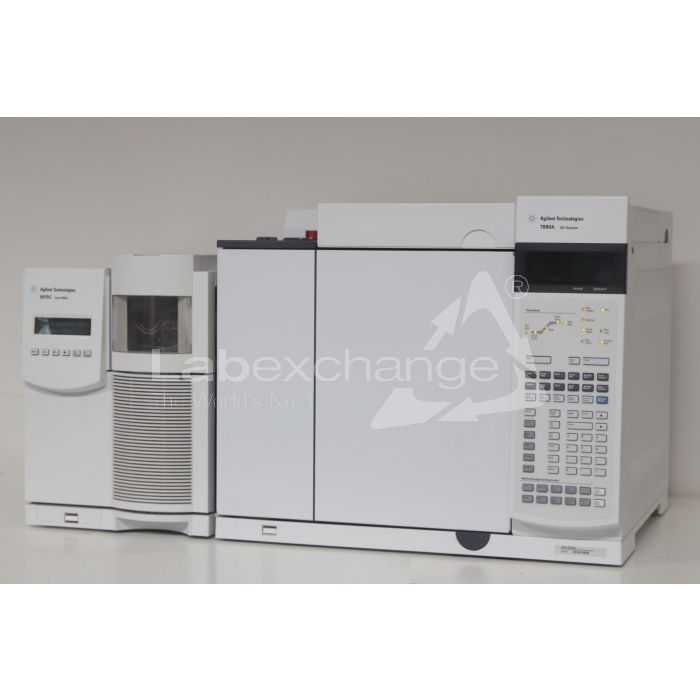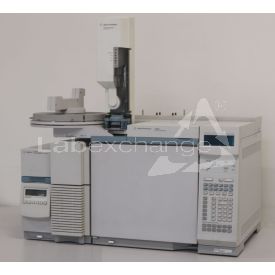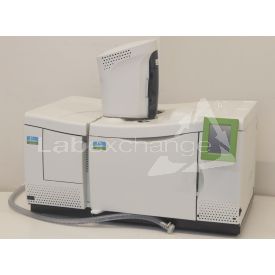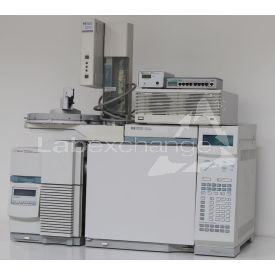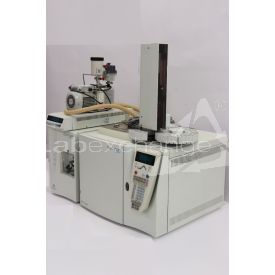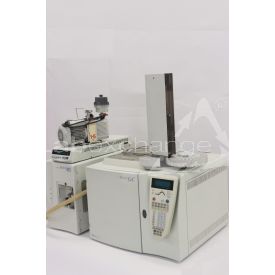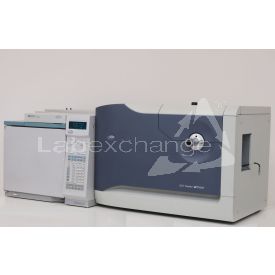Company: Agilent
Model: 7890A
The following illustrations and descriptions are model-based and drawn from brochures.
Do not give the delivery volume again.
The exact delivery content you will find only in the offering text.
For Agilent characteristic performance and reliability
The electronic pneumatics control (EPC) of the fifth generation, and digital electronics set a new benchmark for the precision of Retention Time Locking (RTL) and make the 7890A Agilent's most dependable GC ever.
High efficiency
Faster oven cool down, robust backflush capability, advanced automation features and faster GC / MS oven ramps can ma n more done in less time. At the lowest cost per sample everything is integrated into your existing methods.
Advanced Chromatographiemöglichkeiten
Highly flexible EPC design enables even larger number of sophisticated hydrocarbon analyzes. An optional third detector (TCD) can speed up complex gas analyzes and allows more types of analyzes to be run on a single GC.
Easier to use
The powerful, user-friendly software simplifies method development and system operation and minimizes training time. Practical, time-saving design features speed up and simplify routine maintenance.
QuickSwap
By using an inexpensive QuickSwap coupling can be the column within 30 seconds without venting and without losing vacuum safely solve
Deans Switch
Deans circuits enable two-dimensional GC (Heart Cutting) for analysis of trace constituents in complex samples.
Flow Splitting
By sending a sample to multiple detectors can receive comprehensive information samples in one run. This is especially valuable if you want to analyze components in complex matrices. This technique can help to capture interesting peaks faster to integrate target peaks better and to have a higher confidence in the identification of unknown substances.
Backflushing
Backflushing is a very valuable technique that can be implemented in any flushed Agilent Capillary Flow System. This can improve the quality of the analysis and save time and money on every run. Since BackFlush takes place after the run,
you do not change the method parameters for the chromatographic run.
By reversing column flow immediately after the last interesting component is eluted, you can avoid long bakeout for strongly retained sample components. Instead, these components are pressed backwards through the column and vented through the split vent. Disappearances, contamination, retention time shifts and contamination of the ion source can be prevented in this way
The GC software, perfect for your workflow and your applications
The Agilent GC software makes it even for non-experienced users easy to take advantage of the advanced capabilities of the Agilent 7890A system: from user-friendly and familiar GC and GC / MSD ChemStation and EZChrom Elite chromatography data systems to our fundamentally new Lab Monitor & Diagnostic Software. Everything is designed so that you can make the most of every run and every workday.
If you work in a regulated environment, Agilent software can with comprehensive functions also help to comply with the strict legal, certification and quality assurance provisions of the industry
The 7890A GC is supported by all your data systems.
Regardless of whether one the GC ChemStation, which uses GC / MSD ChemStation, EZChrom Elite or the enterprise-wide Agilent OL system, you can be sure that all support the 7890A GC. As with the earlier 6890 hardware platform provides each of the systems the same simple method development for the 7890A and the full functionality of the Lab Monitor & Diagnostic Software, and also a performance improvement with overlapping ALS and BackFlush.
Another detector, another place and another user - the results are the same, however.
The Retention Time Locking (RTL) software is a powerful tool that makes it possible to reproduce the same results on multiple Agilent GC or GC / MSD systems - and this configuration to configuration, from place to place and from user to user , This breakthrough technology from Agilent makes it possible to reproduce retention times within hundredth Lund even thousands of minutes. RTL enables easy and accurately identify peaks, increase sample throughput, reduce the risk of non-compliance, to promote confidence in the analytical results, and also reduce operating costs
The Lab Monitor & Diagnostic Software maximizes uptime by identifying problems before they occur
The innovative Agilent Lab Monitor & Diagnostic software monitors a single or multiple Agilent GC or GC / MSD systems in real time, to draw attention to GC maintenance or equipment problems before they deteriorate your results.
The software also monitors the number of injections, the uptime and user-defined parameters. Lets you know when to switch Consumables
must be, or performs basic measures for servicing via pop-up, telephone or e-mail from. She performs a quick and easy to set up diagnostic routine to ensure proper instrument performance.
The modular, fully automated Agilent 7890A GC system includes the largest in the industry selection of inlets, detectors, columns, consumables and sample introduction options - in fact everything you need to obtain a laboratory to date and the peak performance upright.
FID with full dynamic range
A hyper modern electrometer enables a linear dynamic range of 107, which is seamlessly integrated into a single run.
Sensitive and selective detection elements
Agilent offers a wide variety of element sensitive detectors, including a flame photometric detector (FPD), which was recently optimized and has a 5-fold sensitivity of sulfur and a 10- to 15-fold sensitivity to phosphorus. The sulfur Chemoluminiszenzdetektor (SCD) provides the highest sensitivity and selectivity for complex applications.
Perfect, efficient partner for the 7890A GC
The Agilent 7683 Automatic Liquid Sampler offers the fastest injection times of any GC autosampler ever, greater solvent capacity, optional multiple injections, dual simultaneous injection and more. The 7683 ALS - the optimal support.
Best ECD productivity
The Agilent electron capture detector (ECD) combines excellent sensitivity and linearity with ruggedness and reliability. One no longer needs to concentrate highly diluted samples and not dilute concentrated samples to remain in the calibration range.
Agilent G1888 headspace sampler for advanced analysis
Automatic task of volatiles from virtually any sample matrix directly into a GC or GC / MS. An inert sample line provides superior chemical performance without analyte degradation or loss.
Increasing the capacity of laboratories with automatic ized sample preparation
The diverse CombiPAL autosampler for liquid injection, headspace and solid phase micro extraction (SPME). The cost GC PAL platform can be assembled for liquid injection only, but offers many other ways of CombiPAL including large volume injection (LVI), multiple sample bottles sizes and extended sample vial capacity.
Agilent J & W High performance columns and supplies for each analytical requirement
The Agilent GC consumables with J & WSäulen has been designed, manufactured and packed in such a maximum guarantees of performance with the Agilent GC and GC / MSD system. It seeks to provide the cleanest, most inert flow path possible. From own deactivated inlet liners on the J & W low bleed columns to injection-molded gold seals samples are protected from exposure to active sites or out-gassed foreign materials which might otherwise affect the results.
Comprehensive selection of inlets to optimize your separations
- Split / splitless (SSL) capillary
- Purged packed column inlet (PPIP)
- Cool on-column (COC)
- Cool on-column with solvent vapor exit (COC SVE)
- Programmable temperature vaporization (PTV)
- Volatiles interface (VI)
- High temperature PTV High pressure gas sample injection
- LPG directly
- Programmable Temperature precolumn
High-sensitivity detectors for every sample type
- Mass selective (Agilent 5975 Series MSD)
- Flame ionization detector (FID)
- Thermal Conductivity (TCD)
- Micro-electron capture (micro-ECD)
- Flame Photometric, single or dual wavelength (FPD)
- Nitrogen-Phosphorus (NPD)
- Sulfur Chemoluminisizenz (SCD)
- Nitrogen Chemoluminiscenz (NCD)
- Atomic emission (AED)
- Pulsed Flame photometric (PFPD)
- Photoionization (PID)
- Electrical conductivity (ELCD)
- Discharge ionization (DID)

